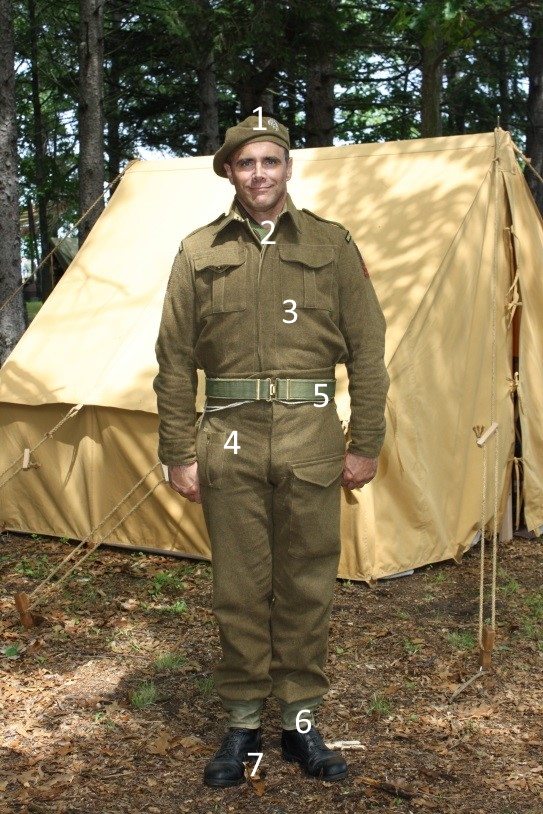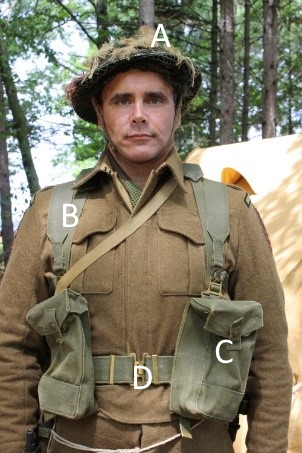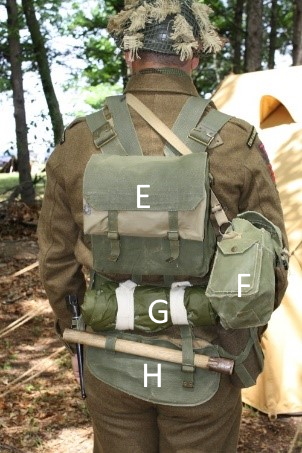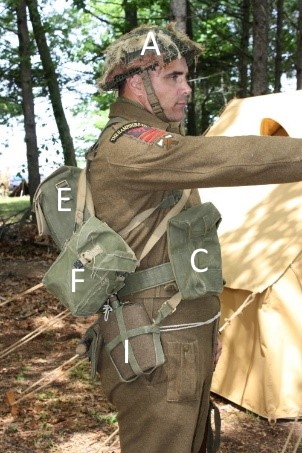The “Impression”
The word “impression” has come into common usage in Living History to mean the person/role/time we try to depict and share with the public. It is rooted in an older usage by Civil War reenactors and living history interpreters at historic sites that do an impression of specific people, talking about them in the first person like an actor.
As modern living historians depicting people, many of whom are still alive, we do not address the public in first person but as guides to the history and a “model” of the soldier rather than a specific person
Hampshire Regiment Soldier 1944 – Northwest Europe
While we have other impressions, this one is our primary one. By this time the British Army had reached the culmination of technology and technique it had been trying to achieve since rearmament in 1937. Improvements to uniforms and equipment had been in development before the first shots of the war but with limited war economy the United Kingdom would only realize this modernity by 1944 and 1945. As a result, the troops that would come ashore on June 6th would be a sight different than those that came over to man the line in 1940.
Uniform
Though WWI style Service Dress was being rapidly replaced in 1939, many soldiers would go through this transition already in France. The new uniform focused on mobility, practicality, and most importantly, cost. The new Battle Dress Uniform would be standard issue for all British soldiers. It proved resilient if inelegant. Economy patterns with exposed plastic buttons were made, but the standard pattern would remain in majority throughout the war. The cap would go through changes in 1943 and 1944, the finer wool field service cap (side cap) would be replaced with the General Service cap (1). While disliked by the soldiers for its deflated appearance it could be made of the same wool as the uniform and stayed on ones head better during non-combat work.

3. Battle Dress Jacket || 4. Battle Dress Trousers
5. Web “walking out” belt || 6. Web gaiters
7. Black toe-capped Ammo Boots.
Equipment
Like the uniform, a new equipment set was laid out in 1937. It would have two main objectives. Firstly it would be more modular and clean than the bulky WWI Pattern 08 gear. Secondly it would make the soldier part of the Bren support system.
To achieve this modular cleanliness the small pack could be taken off separate from the rest of the kit and accessed on the go. Initially it would contain the water bottle and extra personal ammunition. Freeing the universal pouches to contain more bren magazines for the section gunner. Also a spade type shovel was developed to mimic continental armies.
Field use would almost immediately reverse much of this concept. The water bottle was put back on the belt, the shovel discarded for the WWI style pick and helve.
The concept of prioritizing Bren ammunition would remain however. The universal pouches meant every man in the section would bring bren magazines to the fight and keep these critical light machine guns firing in support of the section.
One of the last elements to change would be the helmet. The Mk II helmet developed between the wars, while much like its WWI Mk I counterpart, is simpler and cheaper to produce, also being safer to wear with a finished rim. An improved Mk III helmet was in development and deployment but was so late many units wore the Mk II through the end of the war, the 1st Hampshires among them.
Color is a key aspect of time and place. The British army had long sealed and colored its kit. The white clay of leather gear gave way to colored clay mixtures rubbed into the cotton web gear. This product, colloquially known as Blanco, was used to seal, clean and waterproof the cotton. as well as give a consistent color. Early in the war a bright leafy green was used, a khaki or even white used in the desert. By 1944, a forest green color known as KG No. 3 would be universal across most troops operating in NW Europe.
D. Web Belt E. Small Pack with ground sheet F. Gas Mask
G. Gas Cape H. Entrenching Tool I. Water Bottle w/ Carrier
Interested in Knowing More?
There’s a lot to know if you want to put this kind of kit together, if you’re interested in knowing the details and participating please reach out to us at hampsregt@gmail.com


